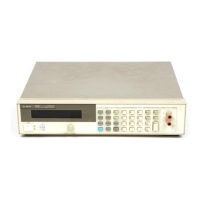8
Principles of Operation
This section describes the operation of the FLT/INH/RLY circuits as shown in the schematic diagram
(Figure 7). The 662x supply automatically recognizes the presence of Option 750 via the ID line (J701/7)
(U214/8 is pulled high with Option 750 installed).
FLT CIRCUIT
The FLT circuit is shown at the top of Figure 7. U701 is driven by the PON line which momentarily holds U701
off when the supply is first turned on. This allows internal nodes within the supply to settle, and prevents false
triggering of any external FLT circuitry. After about one second, the PON line goes high and enables U701.
When the FLT line from the GPIB board goes high (indicating a fault), it causes the output of comparator U702
to go low. This causes current to flow through the diode of opto-isolator U701, which then triggers any external
circuitry connected to the FLT output on the rear of the supply. VR701 protects the FLT circuit by clamping
voltages at U701 to approximately 20Vdc.
INH Circuit
The INH circuit consists of R703 and VR702 (See Figure 7). It is activated by pulling the positive INH input to
ground. VR702 protects the INH circuit by limiting voltages at the INH input to approximately 6Vdc. Note that
correct polarity must be observed when connecting external circuitry to the INH input.
RLY Circuit
As shown in Figure 7, identical circuitry is used in all four RLY controls. The basic RLY circuit consists of a
Shottky diode, a MOSFET, and a 2.15 ohm resistor. These components are connected in series across the
connector terminals. The FET simply acts as switch to open or dose the circuit. It closes when the relay (RLY)
line goes high and positive gate voltage is applied to the FET gate. The zener diode across the FET and resistor
protects the circuit by limiting voltages at the connector terminals to approximately 47Vdc.
In addition to the basic circuit just described, there is additional circuitry consisting primarily of a voltage
comparator and a one-shot that protects the FET and resistor from damage due to excessive current (>140mA).
The voltage comparator compares the voltage drop across the 2.15 ohm resistor to a reference voltage. When
excessive current causes this voltage drop to exceed a predetermined limit, the output of the voltage comparator
goes low. This turns off the FET by removing its positive gate voltage. At the same time, the oneshot applies a
positive pulse to the negative input of the voltage comparator. This keeps the FET off for approximately 1.5ms.
At the end of 1.5ms, the FET is allowed to turn on again. If there is still excessive current flowing through the
RLY circuit, the previously described action is repeated.
Maintenance
The following tests can be performed to ensure that OPTION 750 is functioning properly. The FLT and INH
tests can be performed using either of two methods.
1. Using an external power supply (Agilent 6214B or equivalent), a 3K resistor (Agilent PN 0686-3025 or
equivalent), and an LED (Agilent PN 1990-0486 or equivalent).
2. Using an ohmmeter (Agilent 3456A, Agilent 3478A or equivalent).

